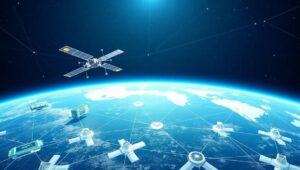IoT in Space: Satellite Constellations and Remote Sensing (2028)
The Internet of Things (IoT) has expanded beyond Earth, with satellite constellations and remote sensing technologies leading the way. By 2028, the integration of IoT devices in space will revolutionize various sectors, providing real-time data and enhanced connectivity.
Satellite Constellations
Satellite constellations consist of numerous satellites working together to provide continuous global coverage. Companies like SpaceX (Starlink), Amazon (Kuiper), and OneWeb are deploying these constellations to offer high-speed internet access to remote areas. In 2028, these constellations will support a vast array of IoT devices, enabling applications such as:
- Global Supply Chain Management: Tracking shipments in real-time, ensuring transparency and efficiency.
- Remote Asset Monitoring: Monitoring pipelines, power grids, and other critical infrastructure in remote locations.
- Precision Agriculture: Providing data on soil conditions, weather patterns, and crop health to optimize farming practices.
Remote Sensing
Remote sensing involves collecting data about Earth’s surface from a distance, typically using satellites or aircraft. In 2028, advanced remote sensing technologies will offer unprecedented insights into our planet, benefiting industries such as:
- Environmental Monitoring: Tracking deforestation, pollution levels, and climate change impacts.
- Disaster Management: Providing early warning systems for natural disasters like floods, wildfires, and earthquakes.
- Urban Planning: Offering data on population density, traffic patterns, and infrastructure development to optimize urban environments.
Challenges and Opportunities
The deployment of IoT in space faces several challenges, including:
- High Costs: Launching and maintaining satellites is expensive.
- Regulatory Issues: Navigating international regulations and spectrum allocation.
- Cybersecurity Threats: Protecting space-based assets from cyberattacks.
Despite these challenges, the opportunities are immense. By 2028, IoT in space will drive innovation, create new business models, and improve the quality of life for billions of people worldwide.
Conclusion
The integration of IoT in space through satellite constellations and remote sensing will transform industries and provide valuable insights into our planet. As technology advances and costs decrease, the potential for IoT in space will only continue to grow.




